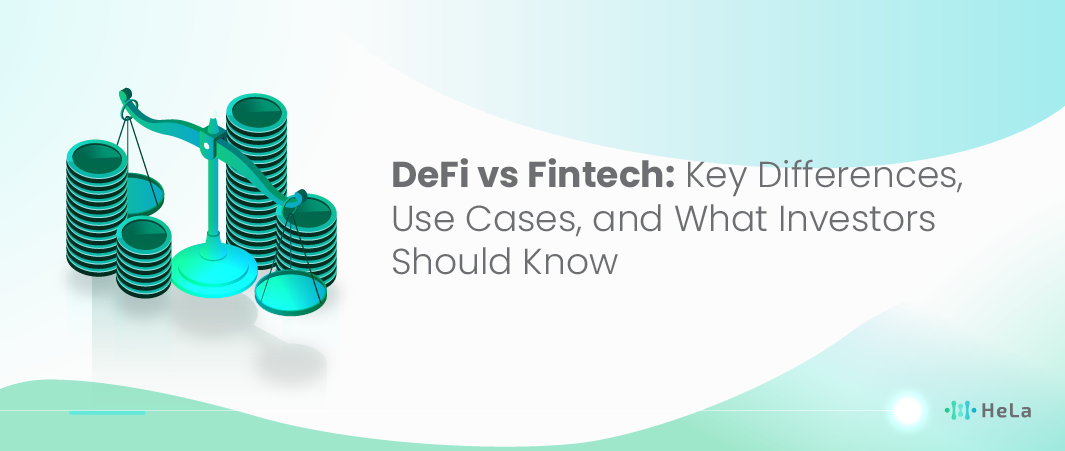In recent years, two terms have gained attention in the world of finance: DeFi and fintech. Both aim to change how people manage and access money. But they do this in very different ways. Understanding their differences is important for anyone involved in finance, especially investors and business leaders.
Fintech stands for “financial technology.” It refers to software and platforms that improve traditional financial services. These include online banks, payment apps, robo-advisors, and many more. DeFi, or decentralized finance, is different. It removes the middlemen and uses blockchain technology to provide services like lending, borrowing, and trading.
In this article, we will compare DeFi vs fintech, show how each works, look at common use cases, and explain what this means for investors. Whether you are new to finance or have experience, this guide will help you make smarter decisions.
What Is Fintech?

Fintech is short for financial technology. It refers to tools, apps, and platforms that use modern tech to improve banking and other financial services. Fintech companies build software to make money management easier, faster, and cheaper for users.
Some common types of fintech products include:
- Mobile banking apps (like Chime, Revolut, or Monzo)
- Payment platforms (like PayPal, Stripe, or Square)
- Investment apps (like Robinhood, Betterment, or Acorns)
- Personal finance tools (like Mint or YNAB)
Fintech companies often work within the rules set by financial regulators. They usually partner with traditional banks or operate with proper licenses. This makes them familiar to most users and easier to trust.
What Is DeFi?

DeFi stands for decentralized finance. It is a new type of financial system built on blockchain technology, mainly on platforms like Ethereum. The key idea behind DeFi is to let people use financial services without needing banks, brokers, or other intermediaries.
In DeFi, smart contracts (code that runs automatically on a blockchain) replace human-made processes. These contracts allow users to:
- Lend or borrow crypto assets
- Trade digital tokens without a central exchange
- Earn interest by providing liquidity to pools
- Use stablecoins to avoid crypto price swings
Unlike fintech, DeFi is permissionless. Anyone with a crypto wallet and internet connection can access DeFi apps. No one controls these services, which also means there’s no customer support or central party to call if something goes wrong.
Also Read: 10 Best Blockchain Fintech Companies to Consider in 2025
DeFi vs Fintech: Key Differences
The biggest difference between DeFi and fintech is in how each is built and who is in control. Fintech companies work within the current financial system. They use technology to improve or speed up existing services, such as banking, lending, or payments. These companies are still run by people or businesses and often need approval from banks or regulators to operate.
DeFi, on the other hand, runs without a central company or bank. It uses blockchain networks and smart contracts—self-running code that doesn’t need human input—to provide similar financial services. Because DeFi is decentralized, no single group or business controls the system. Anyone can use it, change it, or build on top of it.
The table below shows a simple comparison of key differences between DeFi and fintech:
| Feature | DeFi | Fintech |
| Technology | Blockchain | Traditional and modern software |
| Control | Decentralized (no central party) | Centralized (companies and banks) |
| Access | Open to anyone with internet | Often limited by region or ID checks |
| Regulations | Mostly unregulated | Regulated by financial authorities |
| User Trust | Code-based (trust in smart contracts) | Brand and legal trust (licenses) |
| Risks | Code bugs, scams, loss of funds | Business failure, data breaches |
| Support | Community-based or none | Full customer service available |
DeFi gives full control to users but also places full responsibility on them. There are no banks to help recover lost funds or reverse a bad transaction. That’s why trust in the system depends on code quality and peer review. If the code fails or gets hacked, users may lose money with no way to get it back.
Fintech, however, often offers help desks, support centers, and legal options. Users are more protected by law if something goes wrong. Still, these services may not be available to everyone—especially in parts of the world where banking is less developed or tightly restricted.
So while both DeFi and fintech use technology to change finance, their structure, risk, and user experience are very different. Fintech improves the old system. DeFi aims to replace it.
Use Cases and Real-World Applications
Both fintech and DeFi offer tools that make financial services faster, more flexible, and more accessible. But they are designed for different kinds of users and situations. Fintech usually works within existing systems like banks and government regulations. DeFi, by contrast, builds something new from the ground up—open and borderless, but with fewer safety nets.
Let’s take a closer look at what each system can do.
Fintech Use Cases
Fintech aims to make daily financial tasks easier for the average user. Most people using fintech products don’t need to understand how they work in the background—they just want their money to move quickly and safely.
Common fintech use cases include:
- Sending money across borders: Services like PayPal, Wise (formerly TransferWise), and Revolut allow users to send money to friends or family in other countries with lower fees and faster delivery than traditional banks.
- Applying for loans: Online lenders like SoFi, LendingClub, and Upstart give users access to personal loans, often with a fully digital process. Borrowers can apply, get approved, and receive funds without visiting a bank.
- Investing in stocks or ETFs: Platforms such as Robinhood, Acorns, and Betterment make it easy for beginners to invest. These apps often have low or no fees and simple tools to build a portfolio, even with small amounts of money.
- Budgeting and planning: Apps like Mint, YNAB (You Need a Budget), and PocketGuard help users track spending, set saving goals, and get a clearer view of their finances. These tools are especially useful for people looking to stay organized.
These fintech services are most common in countries with reliable banking systems and internet access. They save people time, reduce costs, and add more control over personal finances without changing how the larger financial system works.
DeFi Use Cases
DeFi opens up financial tools to anyone, anywhere, without requiring permission from banks, governments, or companies. Users just need a crypto wallet and internet access. That makes DeFi especially attractive in places where banks are slow, costly, or even unavailable.
Common DeFi use cases include:
- Earning yield on crypto assets: Users can earn passive income by lending their crypto to others or providing liquidity to decentralized platforms. This process is called yield farming or staking, and platforms like Curve, Aave, or Yearn. Finance offers these options.
- Trading assets without a central exchange: With decentralized exchanges (DEXs) like Uniswap, PancakeSwap, or SushiSwap, users can trade tokens directly from their wallets without creating an account or giving up control of their funds.
- Borrowing money without credit checks: DeFi platforms let users borrow crypto by locking up other crypto as collateral. This means anyone can get access to funds without a bank, credit score, or formal income statement—just by using a smart contract.
- Stablecoin payments in unstable economies: In countries with high inflation, people are turning to stablecoins like USDC, DAI, or Tether as a safer way to store and send money. These digital tokens hold their value and can move across borders instantly.
These use cases show how DeFi can solve different problems than fintech. While fintech builds on top of existing systems, DeFi creates new financial systems from scratch. That gives it more freedom but also brings more risk.
Side-by-Side Use Case Comparison
The table below breaks down how fintech and DeFi solve similar problems using different tools:
| Use Case | Fintech Example | DeFi Example |
| Cross-border payments | PayPal, Wise | USDC on Stellar or Ethereum |
| Lending / Borrowing | LendingClub, SoFi | Aave, Compound |
| Investing | Robinhood, Acorns | Synthetix, Mirror Protocol |
| Savings / Earning Yield | High-yield savings accounts | Yield farming with stablecoins |
| Budgeting & Planning | Mint, YNAB | N/A (currently limited in DeFi) |
| Asset Trading | E*TRADE, Fidelity | Uniswap, SushiSwap |
| Access in low-bank areas | Limited | Available globally with a wallet |
As the table shows, fintech provides structured, regulated services that focus on ease of use. DeFi focuses more on open access and self-management. Depending on the user’s needs—convenience, privacy, speed, or availability—one might be more suitable than the other.
Both fintech and DeFi continue to grow, and some services are starting to blend the two. For example, some fintech apps now offer crypto options, and some DeFi projects are exploring legal ways to offer more secure, compliant services.
Benefits and Risks for Investors

Fintech and DeFi both offer new ways for investors to grow their money, but the path, tools, and risks are very different. Understanding how each works can help investors choose wisely and avoid major losses.
Fintech Investment
Investing in fintech usually means buying shares in a company or investing in a fund that includes fintech stocks. These companies often build mobile apps, payment systems, or software for banks. Many are startups, while some are already large, public firms like Square or PayPal.
Benefits of Fintech Investment:
- Easier to research and understand: Fintech companies are structured like other businesses. They release reports, follow accounting rules, and are listed on stock exchanges. Investors can look at earnings, user growth, and market share.
- Often backed by strong business models: Many fintech companies earn money through fees, subscriptions, or financial products. Their income can grow as more people use digital finance tools.
- Regulated by financial laws: These companies must follow government rules, which help protect investors. If something goes wrong, there may be legal action or support for those affected.
Access through standard channels: Investors can use regular brokerage accounts to invest in fintech. No special wallets or crypto knowledge is needed.
Risks of Fintech Investment:
- Heavy competition: The fintech space is crowded. New companies are always entering, and big banks are building their own tech to compete. This can make it hard for any one firm to stay on top.
- Regulatory pressure: Fintech companies must follow strict financial rules. If the rules change, it can increase costs or block growth. For example, tighter lending rules can limit how much these companies can loan.
- Reputation and market trust: If a fintech firm is involved in a data breach or scandal, it can quickly lose customer trust. That can hurt the stock and slow user growth.
Overall, fintech is seen as a safer investment compared to DeFi. It follows known business patterns and offers products that most users understand. However, returns may be slower and depend heavily on the company’s ability to compete in a tough market.
DeFi Investment
DeFi is much newer and less predictable than fintech. Investors in DeFi often buy tokens that represent ownership or participation in a project. These tokens can be traded, staked, or used in DeFi apps for lending, borrowing, or earning rewards.
Benefits of DeFi Investment:
- High yield opportunities: DeFi apps often offer higher returns than banks or fintech. Users can earn interest by staking tokens, joining liquidity pools, or yield farming. In some cases, returns can be over 10% or even higher—but the risks also increase.
- Early access to crypto projects: Many DeFi projects are launched by small developer teams. Investing early in a promising project can lead to large gains if it becomes popular. Token prices can grow fast—sometimes in weeks or days.
- No middlemen: DeFi lets users invest directly without brokers, banks, or financial advisors. This can lower fees and give investors more control over their money.
- Global and open access: Anyone with a crypto wallet can join. There’s no need for approval, documents, or credit checks. This is especially helpful for people in countries with limited banking options.
Risks of DeFi Investment:
- High volatility: Crypto prices move quickly. Tokens can gain value fast, but they can crash just as fast. A project that looks strong today might disappear tomorrow.
- Smart contract bugs and hacks: DeFi runs on code. If the code has errors or is not secure, it can be exploited. Many DeFi platforms have lost millions of dollars to bugs or hacks, with no way to recover the money.
- No legal safety net: Most DeFi projects are not regulated. If something goes wrong, there is usually no legal support or insurance. Investors must take full responsibility for their choices.
- Scams and rug pulls: Since anyone can create a DeFi token, scams are common. In a rug pull, developers take investor funds and vanish. Without regulation, stopping or reversing this is almost impossible.
Investing in DeFi is not like buying shares in a stable company. It’s closer to venture capital: high risk, high reward, and little protection. Investors need technical knowledge, strong risk management, and a high tolerance for losses.
Comparing Investment Profiles
To summarize the key differences, here’s a quick comparison:
| Category | Fintech | DeFi |
| Investment Method | Stocks, equity, venture capital | Tokens, staking, liquidity pools |
| Regulation | Highly regulated | Mostly unregulated |
| Risk Level | Medium | High to very high |
| Returns | Moderate, long-term | Potentially high, short to medium term |
| Access | Through brokers and exchanges | Through crypto wallets and DeFi platforms |
| Transparency | Public reports and audits | Open-source code, but harder to analyze |
| Investor Protection | Legal options available | No legal support if funds are lost |
| Entry Barrier | Low for public stocks | Requires crypto knowledge and wallet setup |
In conclusion, both fintech and DeFi offer investment opportunities, but they appeal to different types of investors. Fintech is safer and easier for beginners or long-term investors. DeFi is for those who are willing to take on higher risk for the chance of higher reward. Smart investors may want to explore both—but only after learning the risks, checking the facts, and deciding how much risk they’re willing to take.
Regulatory Landscape
Regulation plays a major role in shaping how both fintech and DeFi operate, grow, and stay safe for users. For investors, understanding the legal environment behind these systems is just as important as knowing the technology or market trends.
Fintech
Fintech companies operate within the traditional legal framework of financial services. This means they must follow strict local and international laws. These include:
- Anti-money laundering (AML) laws to stop the flow of illegal money
- Know-your-customer (KYC) rules to verify user identity
- Data protection and privacy laws to keep user information secure
- Licensing requirements to operate banking, lending, or payment services
Because fintech works with money and personal data, regulators keep a close watch. While this can slow innovation, it helps build trust with users and gives investors more legal safety.
DeFi
DeFi is very different. Most DeFi platforms are open-source and run without a central company. This means they often fall outside current financial laws. Many projects are launched anonymously, with no clear legal owner or physical location.
This lack of regulation creates both opportunity and risk:
- Opportunity: Developers can build freely, and users can access financial tools without borders or barriers.
- Risk: There’s little to no legal protection. If a DeFi platform fails, gets hacked, or turns out to be a scam, users usually have no recourse.
Some governments are now exploring ways to regulate DeFi, especially as it grows in size and public impact. These efforts include proposals for stricter tax rules, stablecoin oversight, and new licensing systems for decentralized apps.
Also Read: 12 Best Defi Marketing Agencies to Watch this 2025
What Should Investors Know?
Investing in fintech or DeFi isn’t just about following trends—it’s about making informed choices based on your goals, risk comfort, and understanding of each system. Before putting your money into either space, it’s important to pause and consider a few key principles.
Key Guidelines for Investors
Know your risk level: Fintech investments tend to be more stable, often with slower but more predictable returns. DeFi offers higher earning potential, but the risks are greater—prices can swing fast, and losses can happen suddenly.
- Study the product or platform: Whether you’re investing in a fintech company or buying into a DeFi protocol, know what it does, how it makes money, and who is behind it. Look into the technology, the team, and the market it serves.
- Diversify: Don’t rely on a single type of investment. Spread your money across different sectors—DeFi, fintech, and even traditional finance—to lower your overall risk.
- Stay updated: The financial world moves quickly, especially in DeFi. New rules, hacks, or market crashes can happen with little warning. Follow trusted news sources, check project updates, and stay active in online communities.
Smart investing isn’t about choosing between DeFi and fintech. It’s about understanding how each works, being honest about your risk tolerance, and staying informed. With the right strategy, you can benefit from the strengths of both—and avoid the pitfalls that catch many off guard.
Conclusion
DeFi and fintech are changing how people use financial services. Both are tech-driven, but they follow very different paths. Fintech improves current systems, while DeFi tries to build new ones from scratch.
Each comes with its own use cases, risks, and rewards. Fintech is safer and more regulated, but often slower to change. DeFi is faster and open to all, but comes with high risks and little legal safety.
Investors need to be clear about their goals, do solid research, and think carefully about what kind of future they want to support. With the right plan, both DeFi and fintech can offer strong returns and play a part in building the future of finance.
Disclaimer: The information provided by HeLa Labs in this article is intended for general informational purposes and does not reflect the company’s opinion. It is not intended as investment advice or recommendations. Readers are strongly advised to conduct their own thorough research and consult with a qualified financial advisor before making any financial decisions.

Joshua Soriano
I am a writer specializing in decentralized systems, digital assets, and Web3 innovation. I develop research-driven explainers, case studies, and thought leadership that connect blockchain infrastructure, smart contract design, and tokenization models to real-world outcomes.
My work focuses on translating complex technical concepts into clear, actionable narratives for builders, businesses, and investors, highlighting transparency, security, and operational efficiency. Each piece blends primary-source research, protocol documentation, and practitioner insights to surface what matters for adoption and risk reduction, helping teams make informed decisions with precise, accessible content.
- Joshua Soriano#molongui-disabled-link
- Joshua Soriano#molongui-disabled-link
- Joshua Soriano#molongui-disabled-link
- Joshua Soriano#molongui-disabled-link

